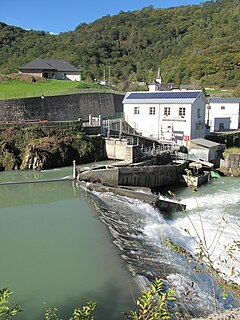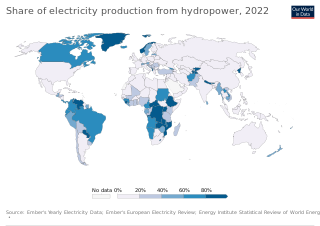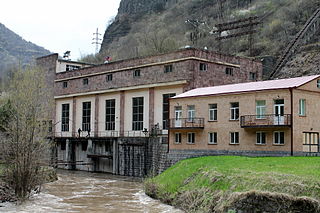Related Research Articles

Small hydro is the development of hydroelectric power on a scale suitable for local community and industry, or to contribute to distributed generation in a regional electricity grid. Exact definitions vary, but a "small hydro" project is less than 50 megawatts (MW), and can be further subdivide by scale into "mini" (<1MW), "micro" (<100 kW), "pico" (<10 kW). In contrast many hydroelectric projects are of enormous size, such as the generating plant at the Three Gorges Dam at 22,500 megawatts or the vast multiple projects of the Tennessee Valley Authority.

Pumped-storage hydroelectricity (PSH), or pumped hydroelectric energy storage (PHES), is a type of hydroelectric energy storage used by electric power systems for load balancing. The method stores energy in the form of gravitational potential energy of water, pumped from a lower elevation reservoir to a higher elevation. Low-cost surplus off-peak electric power is typically used to run the pumps. During periods of high electrical demand, the stored water is released through turbines to produce electric power. Although the losses of the pumping process make the plant a net consumer of energy overall, the system increases revenue by selling more electricity during periods of peak demand, when electricity prices are highest. If the upper lake collects significant rainfall or is fed by a river then the plant may be a net energy producer in the manner of a traditional hydroelectric plant.

Hydroelectricity, or hydroelectric power, is electricity produced from hydropower. In 2015, hydropower generated 16.6% of the world's total electricity and 70% of all renewable electricity, and was expected to increase by about 3.1% each year for the next 25 years.

Dams and reservoirs in Laos are the cornerstone of the Lao government's goal of becoming the "battery of Asia".

The Robert Moses Niagara Hydroelectric Power Station is a hydroelectric power station in Lewiston, New York, near Niagara Falls. Owned and operated by the New York Power Authority (NYPA), the plant diverts water from the Niagara River above Niagara Falls and returns the water into the lower portion of the river near Lake Ontario. It uses 13 generators at an installed capacity of 2,525 MW (3,386,000 hp).

Run-of-river hydroelectricity (ROR) or run-of-the-river hydroelectricity is a type of hydroelectric generation plant whereby little or no water storage is provided. Run-of-the-river power plants may have no water storage at all or a limited amount of storage, in which case the storage reservoir is referred to as pondage. A plant without pondage is subject to seasonal river flows, thus the plant will operate as an intermittent energy source. Conventional hydro uses reservoirs, which regulate water for flood control, dispatchable electrical power, and the provision of fresh water for agriculture.

Dimitrie Leonida (Stejaru) Hydro Power Plant is a hydropower development on the Bistrița River, near Bicaz, Romania.
According to the International Hydropower Association, Canada is the world's fourth largest producer of hydroelectricity in the world in 2021 after the United States, Brazil, and China. In 2014, Canada consumed the equivalent of 85.7 megatonnes worth of oil of hydroelectricity, 9.8% of worldwide hydroelectric consumption. Furthermore, hydroelectricity accounted for 25.7% of Canada's total energy consumption. It is the third-most consumed energy in Canada behind oil and natural gas.
Hydroelectric power in the United States is, as of 2019, the second-largest renewable source of energy in both generation and nominal capacity. In 2019, hydroelectric power produced 38% of the total renewable electricity, and 6.6% of the total U.S. electricity.

The Hòa Bình Dam on the Black River is the largest hydroelectric dam in Vietnam from 1994 to 2012, and one of the largest in Southeast Asia, with a generating capacity of 1,920 MW. The Sông Đà Reservoir, with a capacity of 9 billion m³ was formed as the river was dammed.

Isimba Hydroelectric Power Station is a 183.2 megawatts (245,700 hp) hydroelectric power station commissioned on 21 March 2019 in Uganda. Construction of this dam began in April 2015 and was completed in January 2019. Commercial operations began on 21 March 2019.

The Koyna Hydroelectric Project is the second largest hydroelectric power plant in India, just after Tehri Dam Project. It is a complex project with four dams including the largest dam on the Koyna River, Maharashtra hence the name Koyna Hydroelectric Project. The project site is in Satara district.

Denis-Perron dam is a rockfill embankment dam spanning the Sainte-Marguerite River, a tributary of the lower Saint Lawrence River, in eastern Quebec, Canada. Standing 171 metres (561 ft) high and 378 metres (1,240 ft) long, the dam is the primary component of Hydro-Québec's Sainte-Marguerite 3 hydroelectric project. The dam is the second highest in Quebec and the hydraulic head afforded to its power plant is also the largest in the province.

The Çetin Dam hydropower dam, currently being constructed on the Botan River in Siirt Province, Turkey, with an installed capacity of 420 MW. It is expected to complete by 2020.

Duber Khwar Hydropower Plant is located near the town of Pattan in Kohistan, Khyber Pakhtunkhwa, Pakistan on the Duber Khwar River, a right bank tributary of Indus River. It is approximately 300 km NW from Islamabad, the federal capital of Islamic Republic of Pakistan.
Thailand has set targets and policies for the development of its energy sector for 2035, with priority being given to indigenous renewable energy resources, including hydropower.

The Kulekhani Dam is a rock-fill dam on the Kulekhani River near Kulekhani in Makwanpur District of Narayani Zone, Nepal. The primary purpose of the dam is hydroelectric power generation and it supports the 60 MW Kulekhani I and 32 MW Kulekhani II Hydropower Stations. Construction began in 1977 and Kulekhani I was commissioned in 1982. Kulekhani II was commissioned in 1986 and a third power station, the 14 MW Kulekhani III was expected to be commissioned in May 2015 but was delayed due to issues with the builder. The US$117.84 million project received funding from the World Bank, Kuwait Fund, UNDP, Overseas Economic Cooperation Fund and OPEC Fund. It is owned by Nepal Electricity Authority.

The Dzoraget Hydroelectric Power Station is situated in Dzoraget village, Lori Region, Armenia. The plant is located on the coast of Debed River, but it uses the flows of the waters of Dzoraget River. Construction of the Dzoraget HPP started in 1927 and it was launched on 15 November 1932 with the full installed capacity of 22.32 MW. As of 1980, the plant uses three generators with an installed capacity of 26.2 MW. The Dzoraget Hydro Power Plant is considered to be small size power plant. There is a little water storage behind the weir, as Dzoraget HPP is a run-of-the-river plant.

The Tapovan Vishnugad Hydropower Plant is a 520 MW run-of-river hydroelectric project being constructed on Dhauliganga River in Chamoli District of Uttarakhand, India. The plant is expected to generate over 2.5 TWh of electricity annually.
References
- 1 2 3 Jonathan Nash (July 23, 2018). "Success of Mount Coffee Hydropower Plant Helps Liberia Shine Brighter". Millennium Challenge Corporation blog.
- ↑ The Analyst (January 4, 2005). "Liberia;Liberian Engineer Presents Project For Hydro Dam Construction, But Faces Stone Wall". Africa News.
- 1 2 3 4 "History". Liberia Electricity Corporation. Archived from the original on 2009-02-10. Retrieved 2008-10-26.
- 1 2 3 4 5 First State of the Environment Report for Liberia – 2006. Archived 2009-04-11 at the Wayback Machine United Nations Development Programme. 2006, p. 44–45. Retrieved on October 19, 2008.
- 1 2 3 "Liberia expands hydropower", Engineering News-Record, June 7, 1990. McGraw-Hill, Inc., Vol. 224, No. 23; p. 27.
- ↑ Huband, Mark. "Retreating Liberian rebel leader urges peace talks" United Press International, October 7, 1990.
- ↑ "Worldwide: Liberia blackout", The Independent , July 1, 1990, Foreign News Page, p. 14.
- 1 2 Desk Study on the Environment in Liberia. United Nations Environment Programme. 2004, p. 30. Retrieved on October 19, 2008.
- ↑ The Analyst. "Liberia; Liberian Engineer Presents Project For Hydro Dam Construction, But Faces Stone Wall", Africa News, January 4, 2005.
- ↑ "Weekly Recap", Power, Finance and Risk, March 25, 2005.
- ↑ Liberia's Post-War Recovery: Key Issues and Developments. Congressional Research Service. Retrieved on October 19, 2008.
- ↑ Wrokpoh, Patrick K. (February 25, 2008). "No structural damage done to hydro". The Inquirer.
- 1 2 STAR Radio (August 22, 2008). "Liberia needs about 383m dollars to rebuild hydroelectric plant". BBC Monitoring International Reports. Global News Wire.
- 1 2 "LEC Signs Consulting Services Agreement with Norplan/Fichtner for Mt. Coffee Owner's Engineer". Press and News. Mt Coffee PIU. April 24, 2013. Retrieved 24 September 2013.
- ↑ http://mtcoffeeliberia.com/?p=1878 [ dead link ]
- 1 2 "Montserrado County Development Agenda" (PDF). Republic of Liberia. 2008. Retrieved 2008-10-14.
- ↑ Restoring the Battered and Broken Environment of Liberia One of the Keys to a New and Sustainable Future. United Nations Environment Programme. Retrieved on October 19, 2008.